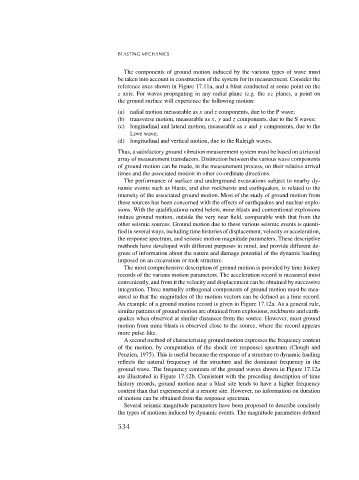Page 552 - Rock Mechanics For Underground Mining
P. 552
BLASTING MECHANICS
The components of ground motion induced by the various types of wave must
be taken into account in construction of the system for its measurement. Consider the
reference axes shown in Figure 17.11a, and a blast conducted at some point on the
z axis. For waves propagating in any radial plane (e.g. the xz plane), a point on
the ground surface will experience the following motion:
(a) radial motion measurable as x and z components, due to the P wave;
(b) transverse motion, measurable as x, y and z components, due to the S waves;
(c) longitudinal and lateral motion, measurable as x and y components, due to the
Love wave;
(d) longitudinal and vertical motion, due to the Raleigh waves.
Thus, a satisfactory ground vibration measurement system must be based on a triaxial
array of measurement transducers. Distinction between the various wave components
of ground motion can be made, in the measurement process, on their relative arrival
times and the associated motion in other co-ordinate directions.
The performance of surface and underground excavations subject to nearby dy-
namic events such as blasts, and also rockbursts and earthquakes, is related to the
intensity of the associated ground motion. Most of the study of ground motion from
these sources has been concerned with the effects of earthquakes and nuclear explo-
sions. With the qualifications noted below, mine blasts and conventional explosions
induce ground motion, outside the very near field, comparable with that from the
other seismic sources. Ground motion due to these various seismic events is quanti-
fied in several ways, including time histories of displacement, velocity or acceleration,
the response spectrum, and seismic motion magnitude parameters. These descriptive
methods have developed with different purposes in mind, and provide different de-
grees of information about the nature and damage potential of the dynamic loading
imposed on an excavation or rock structure.
The most comprehensive description of ground motion is provided by time history
records of the various motion parameters. The acceleration record is measured most
conveniently, and from it the velocity and displacement can be obtained by successive
integration. Three mutually orthogonal components of ground motion must be mea-
sured so that the magnitudes of the motion vectors can be defined as a time record.
An example of a ground motion record is given in Figure 17.12a. As a general rule,
similar patterns of ground motion are obtained from explosions, rockbursts and earth-
quakes when observed at similar distances from the source. However, most ground
motion from mine blasts is observed close to the source, where the record appears
more pulse-like.
A second method of characterising ground motion expresses the frequency content
of the motion, by computation of the shock (or response) spectrum (Clough and
Penzien, 1975). This is useful because the response of a structure to dynamic loading
reflects the natural frequency of the structure and the dominant frequency in the
ground wave. The frequency contents of the ground waves shown in Figure 17.12a
are illustrated in Figure 17.12b. Consistent with the preceding description of time
history records, ground motion near a blast site tends to have a higher frequency
content than that experienced at a remote site. However, no information on duration
of motion can be obtained from the response spectrum.
Several seismic magnitude parameters have been proposed to describe concisely
the types of motions induced by dynamic events. The magnitude parameters defined
534

